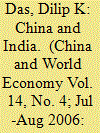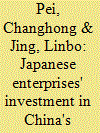|
|
|
Sort Order |
|
|
|
Items / Page
|
|
|
|
|
|
|
| Srl | Item |
| 1 |
ID:
072611


|
|
|
|
|
| Publication |
2006.
|
| Summary/Abstract |
As ancient civilizations China and India had close cultural and commercial ties, but they drifted apart after eleventh century until the mid-twentieth century. In the 1990s, the two emerging-market economies once again began to interact and become economically close. The bilateral relationship was strengthened by political initiatives and determination from both sides. Their mutual trade and investment are on the rise and their new relationship has been evolving in accordance with the new diplomatic stance of conciliation. The bilateral economic bonds are likely to involve both competitive and collaborative dimensions. The two neighbors have determined to develop more extensive cooperation in regional and international affairs.
|
|
|
|
|
|
|
|
|
|
|
|
|
|
|
|
| 2 |
ID:
072609


|
|
|
|
|
| Publication |
2006.
|
| Summary/Abstract |
The rapid growth of energy demand, the lagging growth of energy production and rising pollution problems have raised concerns in several policy areas, including the availability and cost of energy supply and the possibility of further adverse impacts on the environment. This paper begins with an overview of recent developments in energy demand and supply in China. Using a traditional demand elasticity approach, it analyzes the elasticity of each of four major energy end uses and the potential for adjustments in their relationships. The paper concludes with suggestions for public policy to meet the challenge of growing energy demand and implications for the private sector, including both private and foreign investments.
|
|
|
|
|
|
|
|
|
|
|
|
|
|
|
|
| 3 |
ID:
072608


|
|
|
|
|
| Publication |
2006.
|
| Summary/Abstract |
China accounts for 10 percent of global energy use and will continue to rely on coal for generating approximately 75 percent of its energy over coming decades. The environmental problems associated with coal burning are a concern for China as well as regionally and globally. The present paper summarizes China's energy structure and likely future energy requirements, while exploring the impact of energy use on air quality, black carbon emission, sulphur dioxide (SO2) emissions, and carbon dioxide emissions. Although China has begun to take action on local environmental problems from energy, there is still much to be done. In particular, the problem of black carbon and carbon dioxide emissions needs to be addressed. The present paper proposes addressing carbon dioxide emissions through a longer-term strategy that acknowledges the need for China to continue to grow without a short-term carbon constraint but with clear pricing of the short-term and long-term cost of carbon dioxide.
|
|
|
|
|
|
|
|
|
|
|
|
|
|
|
|
| 4 |
ID:
072610


|
|
|
|
|
| Publication |
2006.
|
| Summary/Abstract |
The present paper introduces the overall situation of investment in China by Japanese enterprises. It focuses on the cooperation between Chinese and Japanese enterprises in the software industry. It gives a detailed account of strategic investment by Japanese enterprises, their joint-venture projects with Chinese investors and establishment of R&D centers and laboratories in China's software industry, and it analyzes the problems and prospects of Japanese investment in China's software industry. The paper suggests that it is of vital to maintain friendly Sino-Japanese relations, to strengthen bilateral economic cooperation and to enhance mutual political confidence.
|
|
|
|
|
|
|
|
|
|
|
|
|
|
|
|
| 5 |
ID:
072607


|
|
|
|
|
| Publication |
2006.
|
| Summary/Abstract |
This paper investigates the RMB exchange rate from a long-run viewpoint. Whether China's rapid economic growth brought about real exchange rate appreciation between 1975 and 2002 is empirically examined, based on a supply-side model, the Balassa-Semuelson Hypothesis (BSH). The same test is conducted on Japan, Hong Kong, Korea, Malaysia, Singapore, Thailand, the Philippines, Indonesia and India. Our result indicates that the BSH only exists where the industrial structure has been upgraded and the economy has been successfully transformed from an agricultural economy to a manufacturing economy. Interestingly, China, among those where the BSH does not present, appears to be upgrading its industrial and trade structure. We then try to answer the question of why past rapid growth has no significant relationship with the RMB real exchange rate and what factors are underlying the trend of the RMB real exchange rate. We expect an appreciating trend of RMB real exchange rate in the foreseeable future, presuming that China's industrial upgrading process continues and the factors pertaining to the BSH's prediction, such as rise of wage rates in both tradables and nontradables, become more significant.
|
|
|
|
|
|
|
|
|
|
|
|
|
|
|
|
| 6 |
ID:
072606


|
|
|
|
|
| Publication |
2006.
|
| Summary/Abstract |
The present paper is an attempt to define the contours of the right macroeconomic strategy for China. In a nutshell, we believe that the package includes a decrease in saving, with a focus on private saving, an increase in the supply of services, in particular health services, and an appreciation of the RMB. This is why we refer to this strategy as a "three-handed approach": action on the fiscal and budgetary front, accompanied by currency revaluation. We start by asking how the Chinese economy got to where it is, what the strategy has been since the beginning of the reforms, and what the main characteristics of the economy are today. We then ask what is the desirable path for the future, and which are the main policy trade-offs implied by such a path. Finally, we put the various pieces together to describe what we believe is a consistent policy package.
|
|
|
|
|
|
|
|
|
|
|
|
|
|
|
|
|
|
|
|
|